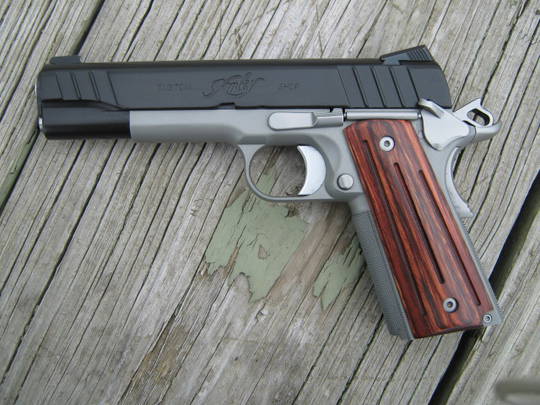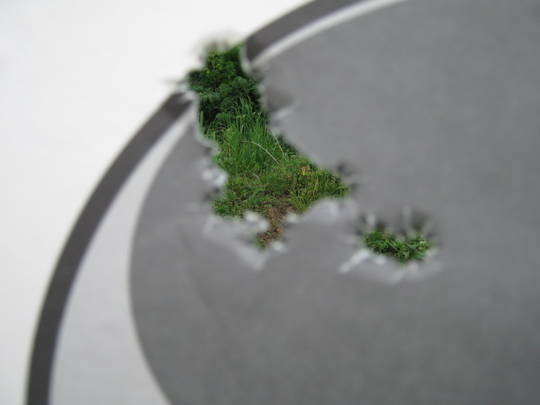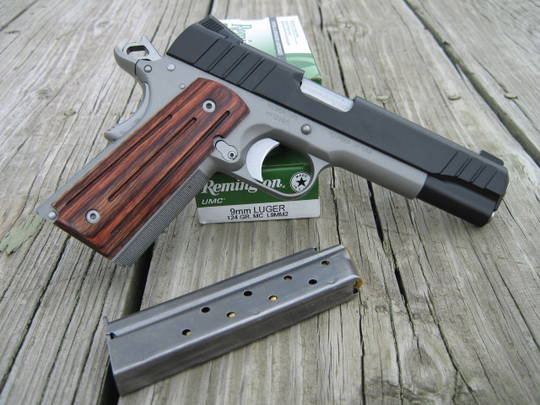NOTE: This product review was made possible by GunsForSale.com. To get up-to-date information on where to find Kimber 1911s for sale, please visit GunsForSale.com.
It seems there’s always room to modify the 1911 to suit the needs of a wider number of users. The idea behind the Aegis II addresses the needs of those with smaller hands or generally smaller in stature. The pistol comes in three sizes. The Ultra Aegis II has a three inch barrel and weighs in at 25 ounces. The next size up is the Pro Aegis II with a four inch barrel weighing 28 ounces. Other than size the pistols are identical. All three are chambered in 9MM.
Just because a 1911 is compact doesn’t mean it helps someone with small hands. Kimber obviously spent some time changing the exterior design to help shooters who have never before gotten along very well with a standard 1911.
Aesthetically Kimber makes a fine looking 1911 and the Aegis II series is no exception. I know when I received this test pistol my first impression was “this is one gorgeous 1911!”
Kimber’s modifications to this particular pistol are numerous. As far as the basics go, the weight is only 31 ounces rather than the usual 38 ounces. The weight reduction on this full size 1911 comes from manufacturing the frame from aluminum (the slide is still steel). Flattening the top of the slide further reduces the weight further, dropping an additional 2 ounces from a normal slide. The frame is fitted with slim fluted Rosewood grips making the grip much smaller. The grip panels are very well done and are darn good looking. The front strap is cut 30 lines per inch providing the user with an excellent grip. The rear of the trigger guard is also undercut providing a higher more secure grip.
The trigger is aluminum and a bit smaller than a medium length which is the one feature that really helps those with smaller hands reach the trigger.
Another interesting change is the magazine release. If you notice in the picture above the release is smooth with beveled edges and an angled cut toward the front. After shooting this full size sample Kimber sent I can’t really see how this change really helps but I suppose their testing showed otherwise. It’s as easy to manipulate as a standard release so no harm no foul.
Next up is the thumb safety. The safety is very similar to the original GI thumb safety. I checked this thumb safety against an old GI one I have and the difference is the Kimber protrudes to the side a bit further giving the shooters thumb a better purchase. If you have small hands you don’t need the longer version so often used these days. Even with my fairly large hands I had no trouble manipulating it even resting my thumb on top of it as I usually do when shooting.
The sights are Meprolight Tritium which are standard on most Kimber models. Meprolight makes an excellent set of sights that are much brighter than any other brand.
| Specifications | |
|---|---|
| Caliber | 9mm Luger/Parabellum |
| Capacity | 9+1 |
| Trigger | Solid aluminum, match grade. 4.0 – 5.0 lb trigger pull |
| Barrel | 5″ match grade |
| Twist | 1:16 (left hand) |
| Finish | Satin silver / Blue |
| Grip | Rosewood |
| Weight | 31 oz. (without magazine) |
| Overall Length | 8.7″ |
| Sights | Tactical Wedge Tritium night sights, fixed |
| MSRP (Price) | $1,277 |
Since this pistol comes from the custom shop the trigger is match grade, as is the barrel and bushing. The slide to frame fit is done by hand. Internal parts are also hand fitted in the custom shop. I used my trigger pull gauge on this sample and it broke crisply and cleanly at 4.2 pounds.

Range Time
After a thorough cleaning I took this beauty to the range along with a couple of hundred rounds of Remington and Blazer ball ammo.
Kimber supplied this test pistol with three magazines, which was much appreciated. Its a real pain shooting a lot of rounds with only one magazine ☺ Each magazine holds nine rounds (plus one in the chamber).
I was somewhat surprised while shooting the first 50 rounds. I had difficulty with function when loading all nine rounds in the magazine. When I racked the slide the top round nose dived locking everything up. Tight springs do that sometimes. I went back and loaded the mags with eight rounds and this took care of that problem. To sum this part of the testing up I had eight malfunctions in the first 100 rounds. Most were stovepipes with two being double feeds which is very unusual.
Now I know some 1911’s that have custom fitted parts require a break-in time. I have to admit I was a bit frustrated. I kept on going though determined to break it in or fix it. I suspected the mainspring might be a bit much for the 9MM. In other words slowing the slide down to the point it wasn’t cycling all the way to the rear. My other consideration was the fully ramped barrel.
Funny, but at about round number 165 the malfunctions stopped. Now whether this was the magazines loosening up or just the pistol itself starting to break-in who knows. It stopped and that’s all that mattered at this point.
I continued with the session firing another 200 rounds with no malfunctions. I decided go for the acid test and mix the mags with various brands of hollowpoints. After firing 75 rounds of hollowpoints with no malfunctions I figured the problems were over and indeed they were.
The picture above shows an average group measuring just over one inch not counting my called flyer just to the bottom right. Darned if I didn’t push that one. It happens to us all☺ Accuracy was very good as you can tell from this target which was fired from the 10 yard line. Even moving back to 25 yards kneeling the groups averaged 2 ¼ inch.
Since I received the Aegis II I’ve fired 500 rounds. After getting past the initial problems there have been no malfunctions of any kind. I suppose this was just one of those times when the pistol indeed needed to be broken in.
Conclusions
If there is one thing you can’t fault Kimber on it’s the beauty of their 1911s. The Aegis series is a very desirable pistol especially for those with small hands. The thought that went into this design is obvious. It fits the intended shooter perfectly.
Considering the light weight, design features even the full size Aegis would be no problem in concealing. When wearing it for a several days in an IWB holster I found it to be very comfortable and the weight barely noticeable.
I have no reservations recommending the Aegis since it has proved itself reliable after the break-in period. Any of the three models should serve you well whether you have small hands or just like a thin 1911 that carries easily. As with any new gun always test it out at the range before carrying it or relying on it to protect your home and family.
 Your Privacy Choices
Your Privacy Choices





